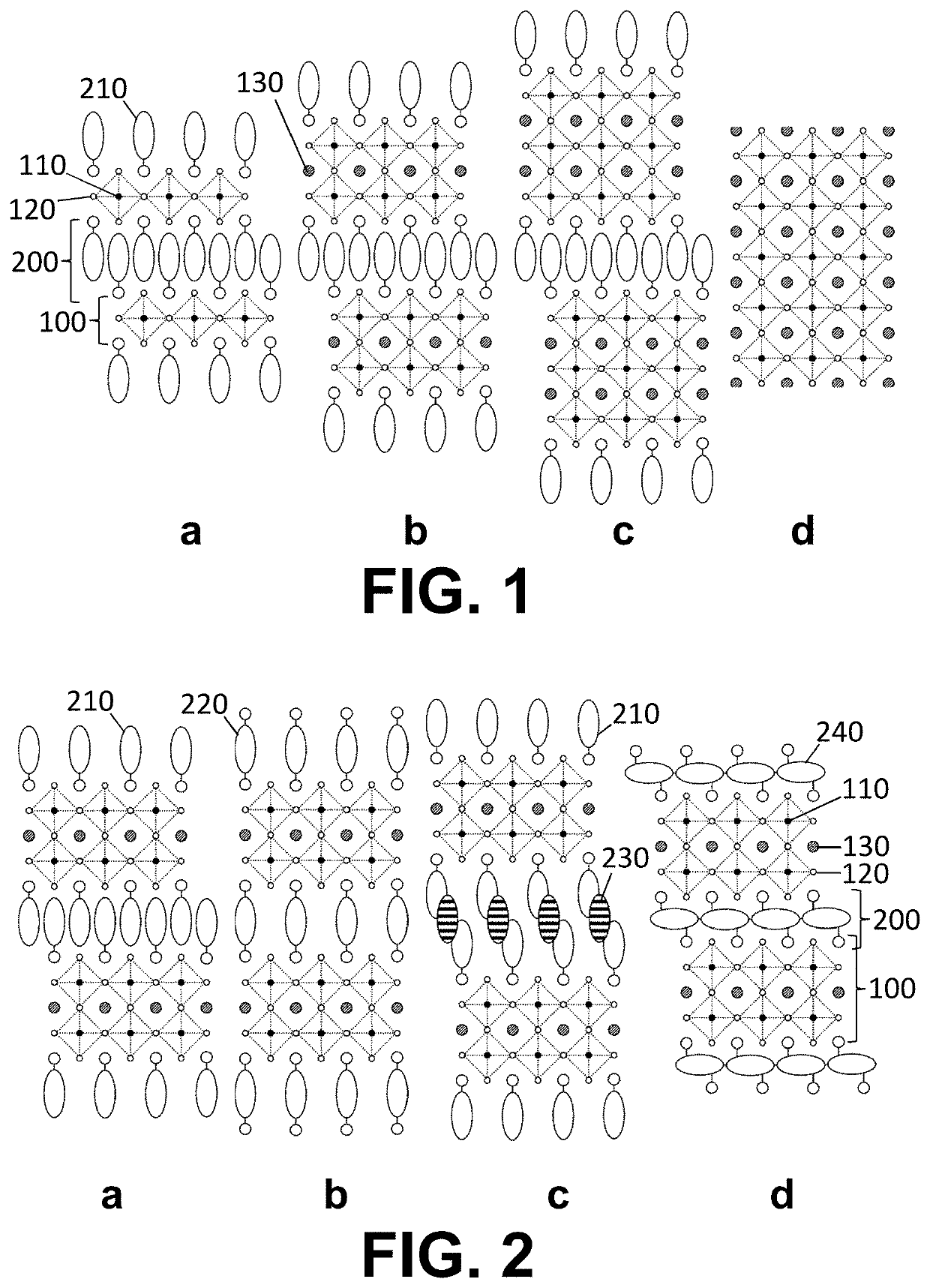Layered hybrid organic-inorganic perovskite materials
a perovskite and organic technology, applied in the manufacture of electrolytic capacitors, light-sensitive devices, electrolytic capacitors, etc., can solve the problems of poor initial power conversion efficiency (pce) of 4.0%, bottleneck preventing commercialization of perovskite photovoltaic cells,
- Summary
- Abstract
- Description
- Claims
- Application Information
AI Technical Summary
Benefits of technology
Problems solved by technology
Method used
Image
Examples
example 1
of Perovskite Material Precursors
example 1a
nium Iodide (MAI) and Phenethylammonium Iodide (PEAI)
[0207]Methylammonium iodide (MAI) and phenethylammonium iodide (PEAI) were synthesized by neutralizing equimolar amounts of hydroiodic acid and methylamine or phenethylamine respectively at 0° C. in an ice bath. In both cases, an off-white precipitate was obtained by evaporation of the solvent using rotary evaporation at 70° C. under reduced pressure. The resulting precipitate was recrystallized three times from ethanol, washed with diethyl ether and dried under reduced pressure.
Example 1b: Carbazole Pentyl Ammonium Iodide (Carb-C5—NH3I or CAI) and Carbazole Butyl Ammonium Iodide (Carb-C4—NH3I or CA′I)
[0208]Shown below is a scheme used for synthesising carbazole pentyl ammonium iodide (carb-C5—NH3I or CAI; V′ where x=5) or carbazole butyl ammonium iodide (carb-C4—NH3I or CA′I; V′ where x=4):
a) 1,n-dibromoalkyl, KO-tBu, THF, 55° C., 10 h. b) Potassium Phthalimide, DMF, 80° C., 6 h. c) Hydrazine Monohydrate (65%), EtOH, 100° C., 2 h...
example 2
of a Perovskite Material
[0227]We now refer to FIG. 1, in which perovskite materials with negatively charged layers (100), comprising M (110), X (120) and L (130), alternating with positively charged layers (200), comprising Q (210), are schematically depicted for different n: n=1 (FIG. 1a), n=2 (FIG. 1b), n=3 (FIG. 1c) and n=∞ (FIG. 1d).
[0228]We now refer to FIG. 2, in which perovskite materials with negatively charged layers (100), comprising M (110), X (120) and L (130), alternating with different positively charged layers (200) are schematically depicted. The positively charged layers (200) comprise:[0229]a monovalent organic ammonium cation Q (210) (FIG. 2a);[0230]a divalent organic ammonium cation Q′ (220) (FIG. 2b);[0231]a compound Q (210) with a further compound (230) intercalated therebetween to form a charge transfer complex (FIG. 2c); alternatively (not depicted) a charge transfer complex may also be formed by a compound Q′ and the further compound, two compounds Q, two co...
PUM
| Property | Measurement | Unit |
|---|---|---|
| angle | aaaaa | aaaaa |
| angle | aaaaa | aaaaa |
| valence | aaaaa | aaaaa |
Abstract
Description
Claims
Application Information
 Login to View More
Login to View More - R&D
- Intellectual Property
- Life Sciences
- Materials
- Tech Scout
- Unparalleled Data Quality
- Higher Quality Content
- 60% Fewer Hallucinations
Browse by: Latest US Patents, China's latest patents, Technical Efficacy Thesaurus, Application Domain, Technology Topic, Popular Technical Reports.
© 2025 PatSnap. All rights reserved.Legal|Privacy policy|Modern Slavery Act Transparency Statement|Sitemap|About US| Contact US: help@patsnap.com



